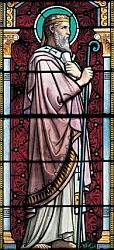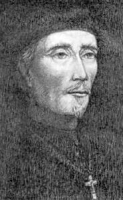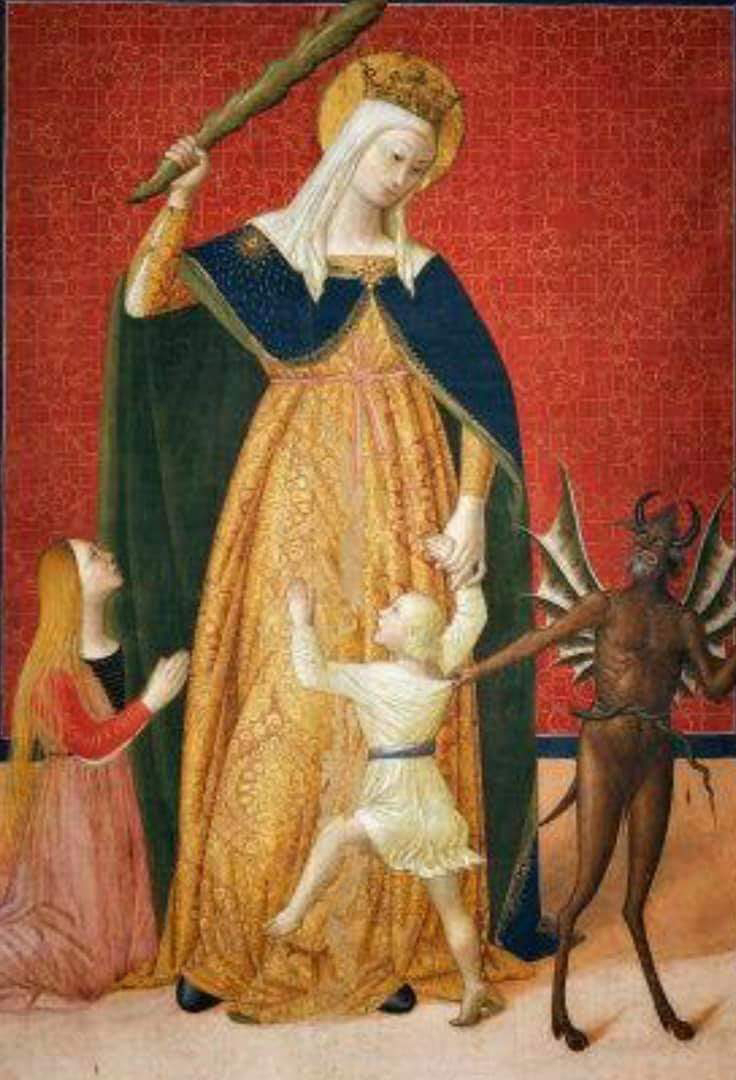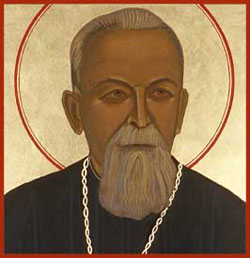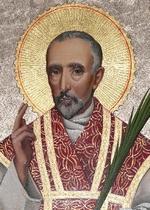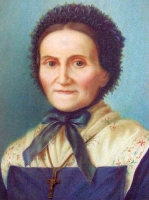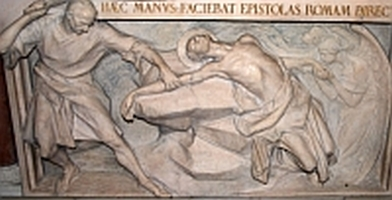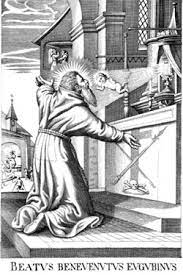St. Cyrus and John
Feastday: June 28
Patron: of Vico Equense
Death: 304
Image of St. Cyrus and John martyrs under Julian in Alexandria, Kemet. (Beheaded Bishop, Prior Dacius (known as Achacius), with Victor, and Iranaeus (known as Irene). Found in the Ethiopian Coptic Church Calendar, 30 Mar.
"Saint Cyrus" redirects here. For the village in Aberdeenshire, see St Cyrus.
Saints Cyrus and John (Italian: Ciro e Giovanni; Arabic: أباكير ويوحنا, romanized: Abākīr wa-Yūḥannā; died c. 304 or 311 AD[1][2]) are venerated as martyrs. They are especially venerated by the Coptic Church and surnamed Wonderworking Unmercenaries (thaumatourgoi anargyroi) because they healed the sick free of charge.
Their feast day is celebrated by the Copts on the sixth day of Tobi, corresponding to 31 January, the day also observed by the Eastern Orthodox Church; on the same day they are commemorated in the Roman Martyrology. The Eastern Orthodox Church celebrate also the finding and translation of their relics on 28 June.[3]
Life and historicity
The principal source of information regarding the life, passion and miracles of Sts. John and Cyrus is the encomium written by Sophronius, Patriarch of Jerusalem (d. 638). Of the birth, parents, and first years of the saints we know nothing. According to the Arabic "Synaxarium", compiled by Michael, Bishop of Athrib and Malig, Cyrus and John were both Alexandrians; this, however, is contradicted by other documents in which it is said that Cyrus was a native of Alexandria and John of Edessa.[3]
Cyrus
Cyrus practised the art of medicine, and had a workshop (ergasterium) which was afterwards transformed into a temple (church) dedicated to Shadrach, Meshach, and Abednego. He ministered to the sick gratis and at the same time laboured with all the ardour of an apostle of the Faith, and won many from pagan superstition. He would say, “Whoever wishes to avoid being ill should refrain from sin, for sin is often the cause of bodily illness.” [4] This took place under the Emperor Diocletian. Denounced to the prefect of the city he fled to Arabia where he took refuge in a town near the sea called Tzoten. There, having received the tonsure and assumed the monastic habit, he abandoned medicine and began a life of asceticism.[3]
John
John belonged to the army, in which he held a high rank; the "Synaxarium" cited above adds that he was one of the familiars of the emperor. Hearing of the virtues and wonders of Cyrus, he went to Jerusalem in fulfillment of a vow, and thence passed to Alexandria and then to Arabia where he became the companion of St. Cyrus in the ascetic life.[4]
Miniature from the Menologion of Basil II
During the persecution of Diocletian three holy virgins, fifteen-year-old Theoctista (Theopista), Theodota (Theodora), thirteen years old, and Theodossia (Theodoxia), eleven years old, together with their mother Athanasia, were arrested at Canopus and brought to Alexandria. Cyrus and John, fearing lest these girls, on account of their youth, might, in the midst of torments, deny the Faith, resolved to go into the city to comfort them and encourage them in undergoing martyrdom.[4] This fact becoming known they also were arrested and after dire torments they were all beheaded on the 31st of January.[3]
Veneration
The bodies of the two martyrs were placed in the church of St. Mark the Evangelist in Alexandria.
At the time of St. Cyril, Patriarch of Alexandria (412-444), there existed at Menuthis (Menouthes or Menouthis) near Canopus and present-day Abu Qir, a pagan temple reputed for its oracles and cures which attracted even some simple Christians of the vicinity.[3] St. Cyril thought to extirpate this idolatrous cult by establishing in that town the cultus of Saints Cyrus and John. For this purpose he moved their relics (28 June, 414) and placed them in the church built by his predecessor, Theophilus, in honour of the Four Evangelists.
Before the finding and transfer of the relics by St. Cyril it seems that the names of the two saints were unknown; it is certain that no written records of them were known prior to then.[5] In the fifth century, during the pontificate of Pope Innocent I, their relics were brought to Rome by two monks, Grimaldus and Arnulfus—this according to a manuscript in the archives of the deaconry of Santa Maria in Via Lata, cited by Antonio Bosio.[6]
Cardinal Angelo Mai, however, for historical reasons, justly assigns a later date, namely 634, under Pope Honorius I and the Emperor Heraclius (Spicilegium Rom., III, V). The relics were placed in the suburban church of Santa Passera (a linguistic corruption of "Abbas Cyrus") on the Via Portuense. In the time of Bosio the pictures of the two saints were still visible in this church.[6] Upon the door of the hypogeum, which still remains, is the following inscription in marble:
Corpora sancta Cyri renitent hic atque Joannis
Quæ quondam Romæ dedit Alexandria magna[3]
Their tomb became a shrine and place of pilgrimage. In Coptic Cyrus' name became Difnar, Apakiri, Apakyri, Apakyr; in Arabic, 'Abaqir, 'Abuqir. The city of Abu Qir, now a suburb of Alexandria, was named after him.
At Rome three churches were dedicated to these martyrs, Abbas Cyrus de Militiis, Abbas Cyrus de Valeriis, and Abbas Cyrus ad Elephantum — all of which were transformed afterwards by the vulgar pronunciation into S. Passera, a corruption of Abbas Cyrus.[3]
In the Eastern Orthodox Church and those Eastern Catholic Churches which follow the Byzantine Rite, Cyrus and John are among the saints who are commemorated during the Liturgy of Preparation in the Divine Liturgy.
Saint Irenaeus of Lyons
புனித இரேனியுஸ் (St. Irenaeus)
ஆயர், மறைவல்லுநர், மறைசாட்சி
பிறப்பு
130
இறப்பு
28 ஜூன் 200
இரேனியுஸ் என்ற சொல்லுக்கு "அமைதி விரும்பி" என்பது பொருள். இவர் தம் பெயருக்கேற்ப அமைதியின் மூலம் பல அருஞ்செயல்களை நிலைநாட்டி திருச்சபைக்கு பேரும் புகழும் தேடித்தந்தார். இவர் 2 ஆம் நூற்றாண்டின் சிறப்பான மறைவல்லுநர். புனித போலிக்கார்ப்பின் சீடர் லயன்ஸ்(Lions) நகர்புறத்துக் கிறிஸ்தவர்களின் ஆயராயிருந்தார். இவர்களின் பொருட்டு ஒருமுறை உரோமை சென்றார். பிறகு ஒரு முறை சிறிய ஆசியாவிலிருந்த கிறிஸ்தவர்களுக்காக பரிந்துரைக்கவும் திருத்தந்தையை சந்திக்க சென்றார்.
இவர் ஆற்றிய திறமைமிக்க பெரும்பணி நாஸ்டிக் (Gnostic) என்று சொல்லப்பட்ட தப்பறையை தம் பெயருக்கே உரிய அமைதியான முறையில் எடுத்துரைத்ததாகும். தொடக்கத்தில் உருவமற்ற பொருள் ஒன்று இருந்தது. இதிலிருந்தே தெய்வ தன்மையுடனிருந்த ஒருவரின் குறுக்கீட்டால் இவ்வுலகம் தோன்றியது என்பது இந்த தப்பறையின் சாரமாகும். 177 ஆம் ஆண்டு கொடுங்கோல் மன்னனும் மெய்மறை பகைவனுமான மார்க் அவுரேலியஸ்(Aurelias) ஆட்சியில் பயங்கரமான வேதகலாபனை தோன்றியது. இச்சூழலில்தான், சிறையில் அகப்பட்ட குருக்கள் சிலர், சிறையில் அகப்படாத இவரை உரோமை நகருக்கு அனுப்பினார்கள். பிறகு இருவரும் பாப்பரசரிடம் உண்மை நிலையை எடுத்துக் கூறினர். இவர் உரோமையிலிருந்து வருவதற்குள் ஆயரான புனித போட்டினுசும்,(Botinus) அவரோடு குருக்கள் பலரும் வேதத்திற்காக தங்கள் இரத்தத்தை சிந்தி சாட்சி பகர்ந்து, இவ்வுலகை விட்டு பிரிந்தனர். இச்சூழலில் இவர் திரும்பி வரவே ஆயராக நியமிக்கப்பட்டார். 24 ஆண்டுகள் ஆயராக பணியாற்றி பலரை மனந்திருப்பினார். பல மெய்மறை நூல்களை எழுதினார். இதன் வழியாகவும் பலரை இறைவன் பால் ஈர்த்தார்.
Also known as
Ireneo
Profile
Disciple of Saint Polycarp of Smyrna. Ordained in 177. Bishop of Lugdunum, Gaul (modern Lyons, France). Worked and wrote against Gnosticism, basing his arguments on the works of Saint John the Apostle, whose Gospel is often cited by Gnostics. Dispatched evangelists, including Saint Ferreolus of Besançon and Saint Ferrutio of Besançon. Considered the first great Western ecclesiastical writer and theologian, he emphasized the unity of the Old and New Testaments, and of Christ's simultaneous human and divine nature, and the value of tradition. A Father of the Church. Martyr.
Born
c.130 in Smyrna, Asia Minor (modern Izmir, Turkey)
Died
• martyred in 202 in Lyons, France
• tomb and relics were destroyed by Calvinists in 1562
• head in Saint John's church, Lyons, France
Blessed Teresa Maria Mastena
Also known as
• Maria Pia Mastena
• Mother Maria Pia
• Sister Passitea of the Child Jesus
Profile
Eldest of five children of Giulio Mastena, a grocer, and Maria Antonia Casarotti, an elementary school teacher. Raised in a pious family; one brother was a priest, another tried to be, and a sister became a tertiary. Received First Communion on 19 March 1891, during which she made a private vow of chastity. Received Confirmation on 29 August 1891. Feeling a call to religious life, she tried to take the veil at age 14, but was considered too young. At age 17 she joined the Institute of the Sisters of Mercy in Verona, Italy. On 24 October 1903 she made her profession, and received the name Sister Passitea of the Child Jesus.
In the cloister she was known for strict adherence to the rules, and devotion to the Eucharist, to the Passion of Jesus, and to his Holy Face. However, she soon began to realize that the cloistered life was not for her, and she returned to service as head-mistress of the school in Miane, Italy. She was transferred to schools in Carpesica, Italy, and then to San Fior, Italy. In 1930 in San Fior she founded the Institute of Sisters of the Holy Face with the mission to "propagate, repair and restore Jesus' gentle image in souls". On 8 December 1936 the Institute was canonically erected as a diocesan Congregation, and the first ten members made their perpetual vows, and Mother Maria Pia was appointed Superior General, a position she held the rest of her life.
Born
7 December 1881 in Bovolone, Verona, Italy as Teresa Maria Mastena
Died
• during the evening of 28 June 1951 in Rome, Italy of a heart attack while working to start a new house of the Institute
• interred in the chapel of the Institute convent in San Fior, Italy
Beatified
• 13 November 2005 by Pope Benedict XVI
• recognition celebrated by Cardinal Saraiva Martins at Saint Peter's Basilica, Rome, Italy
Saint John Southworth
Additional Memorials
• 25 October as one of the Forty Martyrs of England and Wales
• 29 October as one of the Martyrs of Douai
Profile
Studied and was ordained at the English College, Douai, France. he returned to England on 13 October 1619 to minister to covert Catholics. Arrested and condemned to death for his faith in Lancashire in 1627; he was held in various prisons, at one point hearing the final confession of Saint Edmund Arrowsmith just before that martyr was led to the gallows. Through the intercession of Queen Henrietta Maria, he and fifteen other priests were turned over to the French ambassador on 11 April 1630 to be sent into exile in France.
Soon after, Father John returned to England, working with Saint Henry Morse. They worked tirelessly and fearlessly with the sick during a plague outbreak in 1636. He was arrested again for his faith in Westminster on 28 November 1637. Held in various prisons until 16 July 1640 when he was released due to the mitigating circumstances of his good works.
Arrested again on 2 December 1640; he pled guilty to the crime of priesthood, and was condemned to death. After 14 years in prison, during which he ministered to any prisoners who showed interest, he was executed by orders of the Commonwealth under Oliver Cromwell. One of the Forty Martyrs of England and Wales.
Born
1592 at Samlesbury, Lancashire, England
Died
• hanged, drawn, and quartered on 28 June 1654 at Tyburn, London, England
• remains purchased by the Spanish ambassador to England, and sent to the English College in Douai, France
• the relics were hidden to prevent destruction during the French Revolution, were rediscovered in 1927, and are now housed at Westminster Cathedral, London
Canonized
25 October 1970 by Pope Paul VI
Blessed Yakym Senkivsky
Also known as
• Jakym Senkivskyj
• Yakym Sen'kiv'skyi
• Ivan Sen'kiv'skyi
• Ivan Senkivsky
• Gioacchino Senkivskyj
Additional Memorial
27 June as one of the Martyrs Killed Under Communist Regimes in Eastern Europe
Profile
Greek Catholic. Studied theology at Lviv. Ordained on 4 December 1921. Obtained his Doctorate in theology from Innsbruck, Austria. Novice in the Basilian Order of Saint Josaphat at Krekhiv in 1923. Assigned to the village of Krasnopushcha, then Lavriv. Held various positions at the Saint Onufry monastery at Lviv from 1931 to 1938. Prior at the monastery at Drohobych in 1939. Arrested for his faith on 26 June 1941 by Communist authorities. Murdered in prison; martyr.
Born
2 May 1896 at Haji Velyki, Ternopil District, Ukraine
Died
boiled to death in a cauldron on 29 June 1941 in Drohobych prison, Ukrainian Galicia
Beatified
27 June 2001 by Pope John Paul II at Ukraine
Blessed Severian Baranyk
Also known as
• Severiano Baranyk
• Severijan Baranyk
• Stepan Baranyk
Profile
Greek Catholic. Entered the Krekhiv monastery of the Basilian Order of Saint Josaphat on 24 September 1904, and made his final vows on 21 September 1910. Ordained on 14 February 1915. Prior of the Basilian monastery in Drohobych in 1932. Arrested for his faith on 26 June 1941 by the NKVD. Never seen alive again by outsiders; a boy later testified he saw the tortured corpse of Father Severian, marked with a cross-shaped knife slash on his chest.
Born
18 July 1889 in Ukraine
Died
• late June 1941 by the Soviets at Drohobych, Ukrainian Galicia
• his body has not been found
• some evidence indicates the body was boiled and served as soup to prisoners
Beatified
27 June 2001 by Pope John Paul II at Ukraine
Saint Vincentia Gerosa
புனித வின்சென்ஸோ ஜெரோசா (1784-1847) June 28
இவர் இத்தாலியில் உள்ள லோவேரே என்ற இடத்தில் பிறந்தவர்.
இவர் தன்னுடைய பதின்வயதில் தனது பெற்றோரை இழந்து அனாதையானார். இதனால் இவருக்கு ஏழைகள்மீது தனிப்பட்ட அன்பு உண்டானது.
1824 ஆம் ஆண்டு இவருக்கு பர்த்தலமேயு கேபிடானியோ என்பவருடைய நட்பு கிடைத்தது. இவர்கள் இருவரும் இணைந்து 'அன்பின் பணியாளர்கள்' என்ற சபையைத் தோற்றுவித்தார்கள்.
இச்சபை மூலம் இவர்கள் இருவரும் நோயாளர்களைக் கவனித்தும், ஏழைகளுக்கு உதவிசெய்தும், வறிய நிலையிலிருந்த குழந்தைகளுக்கு கல்வியும் புகட்டி வந்தார்கள்.
1833ஆம் ஆண்டு பர்த்தலமேயு கேபிடானியோ திடீரென இறந்து விடவே, இவரே சபையை முன்னின்று வழி நடத்த வேண்டிய சூழ்நிலை ஏற்பட்டது
இதற்குப் பின்பு இவர் நோயாளர்களைக் கவனித்துகொள்வதிலும், ஏழைகளுக்கு உதவிசெய்வதிலும், வறியநிலையிலிருந்த குழந்தைகளுக்குக் கல்வி புகட்டுவதில் மிகுந்த ஈடுபாடு காட்டினார்
இதனால் இவருடைய உடல்நலம் குன்றி 1847ஆம் ஆண்டு இறையடி சேர்ந்தார். இவருக்கு 1975 ஆம் ஆண்டு திருத்தந்தை ஆறாம் பவுல் புனிதர் பட்டம் கொடுத்தார்
Also known as
• Catherine Gerosa
• Vincenza Gerosa
Profile
Orphaned young. Spent 40 years as a homemaker and lay woman devoted to care for the poor. Around 1832 she and Saint Bartholomea Capitanio formed the Sisters of Charity of Lovere, a congregation for the welfare and support of sick poor people, and for the education of poor children; Catherine joined the congregation, taking the name Vincentia. She enjoyed tending grapevines destined for sacramental wine; as she worked, she meditated on their conversion to the Blood of Christ. She assumed leadership of the congregation in 1836 on the death of Saint Bartholomea, and led the congregation until her own death.
Born
1784 at Lovere, Bergamo, Italy as Catherine Gerosa
Died
28 June 1847 at Lovere, Bergamo, Italy following an extended illness
Canonized
18 May 1950 by Pope Pius XII
Pope Saint Paul I
Profile
Brother of Pope Stephen II. Orphaned young. Educated at the Lateran school. Deacon under Pope Zachary. Ordained in Rome, Italy. Noted for his gentleness and his charity, spiritual and monetary. Papal diplomat for his brother, recovering Papal State property from the invading Lombards. Succeeded his brother as 93rd pope on 29 May 757.
Worked with King Pepin the Short and to maintain the papacy's temporal power. In 765 he settled an agreement with the Byzantine Desiderius regarding their boundaries. Built churches and monasteries in Rome. Opposed the iconoclastic emperor Constantine Coproynmus, and sheltered refugees from his oppression.
Born
at Rome, Italy
Papal Ascension
29 May 757
Died
28 June 767 at Saint Paul's Outside the Walls, Rome, Italy of natural causes
Blessed Sabas Ji Hwang
Additional Memorial
Saba Hong Ji
Additional Memorial
20 September as one of the Martyrs of Korea
Profile
Layman catechist in the apostolic vicariate of Korea. Arrested, tortured and executed for assisting Blessed Iacobus Chu Mun-mo. Martyr.
Born
1767 in Seoul, South Korea
Died
beaten to death on 28 June 1795 in Seoul, South Korea
Beatified
15 August 2014 by Pope Francis
Saint Heimrad
Also known as
Eimerado, Heimerad, Heimo
Profile
Priest. Made several pilgrimages to holy sites. He was so unworldly, his mind so much on spiritual matters that many of the people he met thought he was a lunatic. After years of travel, he decided to settle as a Benedictine monk. After some time in the community, he retired to become a hermit at Hasungen, Westphalia (in modern Germany).
Born
at Baden, Germany
Died
1019 of natural causes
Saint Maria Chi Yu
Also known as
• Mali
• Chi Yu Maria
• Maria Ts'i-u
Profile
Girl who grew up in an Christian-run orphanage in Wangla, apostolic vicariate of Southeastern Zhili, China. Martyred in the Boxer Rebellion.
Born
c.1885 in Daji, Wuqiao, Hebei, China
Died
28 June 1900 in Wangla, Dongguang, Hebei, China
Canonized
1 October 2000 by Pope John Paul II
Saint Lucia Wang Cheng
Also known as
Luqi, Lucy
Profile
Girl who grew up in an Christian-run orphanage in Wangla, apostolic vicariate of Southeastern Zhili, China. Martyred in the Boxer Rebellion.
Born
c.1882 in Laochuntan, Ningjing, Hebei, China
Died
28 June 1900 in Wangla, Dongguang, Hebei, China
Canonized
1 October 2000 by Pope John Paul II
Saint Maria Du Zhauzhi
Also known as
Mali
Profile
Married lay woman in the apostolic vicariate of Southeastern Zhili, China. Mother of a priest. Martyred in the Boxer Rebellion.
Born
c.1849 in Qifengzhuang, Shenzhou, Hebei, China
Died
28 June 1900 in Wangjiatian, Hengshui City, Hebei, China
Canonized
1 October 2000 by Pope John Paul II
Blessed Matthaeus Choe In-gil
Additional Memorial
20 September as one of the Martyrs of Korea
Profile
Layman in the apostolic vicariate of Korea, martyred for assisting Blessed Iacobus Chu Mun-mo.
Born
1764 in Seoul, South Korea
Died
28 June 1795 in Seoul, South Korea
Beatified
15 August 2014 by Pope Francis
Saint Maria Zheng Xu
Also known as
Mali
Profile
Girl who grew up in an Christian-run orphanage in Wangla, apostolic vicariate of Southeastern Zhili, China. Martyred in the Boxer Rebellion.
Born
c.1889 in Kou, Dongguang, Hebei, China
Died
28 June 1900 in Wangla, Dongguang, Hebei, China
Canonized
1 October 2000 by Pope John Paul II
Saint Maria Fan Kun
Also known as
Mali
Profile
Girl who grew up in an Christian-run orphanage in Wangla, apostolic vicariate of Southeastern Zhili, China. Martyred in the Boxer Rebellion.
Born
c.1884 in Daji, Wuqiao, Hebei, China
Died
28 June 1900 in Wangla, Dongguang, Hebei, China
Canonized
1 October 2000 by Pope John Paul II
Blessed Paulus Yun Yu-il
Additional Memorial
20 September as one of the Martyrs of Korea
Profile
Layman in the apostolic vicariate of Korea, martyred for assisting Blessed Iacobus Chu Mun-mo.
Born
1760 in Yeoju, Geonggi-do, South Korea
Died
28 June 1795 in Seoul, South Korea
Beatified
15 August 2014 by Pope Francis
Saint Argymirus of Cordoba
Also known as
Argimiro, Argimirus
Profile
Government official in Cordoba, Spain during the Moorish occupation, but he lost his position due to being a Christian. Monk. Soon after his profession he responded to inquiries by renouncing Islam and declaring his loyalty to Christ. Martyr.
Born
Cabra, Spain
Died
beheaded in 856
Saint Benignus of Utrecht
Profile
Bishop of Chartres, France. Bishop of Utrecht, Netherlands. Saint Gregory of Tours wrote about an apparition of Benignus.
Born
France
Died
• 6th century of natural causes
• relics re-discovered in Utrecht in 996
Saint Attilio of Trino
Also known as
Attilius
Profile
Soldier. Martyr. Some records make him part of the Theban Legion, others not.
Died
c.300 in northern Italy
Saint Austell of Cornwall
Also known as
Austol, Hawystill
Profile
Spiritual student of Saint Mewan of Bretagne. He probably lived in the area now known as Saint Austol.
Died
6th century at Saint-Meen, Brittany, France of natural causes
Saint Papias the Martyr
Also known as
Papius
Profile
Tortured and martyred in the persecutions of Diocletian.
Died
beheaded c.303, possibly in Sicily
Blessed Almus of Balmerino
Also known as
Alme, Alanus
Profile
13th century Cistercian monk in Melrose, England. First abbot of Balmerino Abbey, founded c.1228.
Died
1270 of natural causes
Saint Egilo
Also known as
Egilon, Eigil
Profile
Monk. Abbot of Prüm Abbey near Trier, Germany. Restored the monastery at Flavigny, France. Founded the monastery of Corbigny, France.
Died
871 of natural causes
Saint Theodichildis
Also known as
Telchildis
Profile
Nun at Faremoutiers, France. First Abbess of Jouarre Abbey, Seine-et-Marne, France.
Died
c.660
Blessed Damian of Campania
Also known as
Damiano, Damianus
Profile
Franciscan Friar Minor.
Saint Crummine
Profile
Spiritual student of Saint Patrick. Missionary bishop at Leccuine, Westmeath, Ireland.
Saint Lupercio
Profile
Martyr.
Martyrs of Africa
Profile
27 Christians martyred together. The only details about them to survive are the names – Afesius, Alexander, Amfamon, Apollonius, Arion, Capitolinus, Capitulinus, Crescens, Dionusius, Dioscorus, Elafa, Eunuchus, Fabian, Felix, Fisocius, Gurdinus, Hinus, Meleus, Nica, Nisia, Pannus, Panubrius, Plebrius, Pleosus, Theoma, Tubonus and Venustus.
Died
unknown location in Africa, date unknown
Martyrs of Alexandria
Profile
A group of spiritual students of Origen who were martyred together in the persecutions of emperor Septimius Severus - Heraclides, Heron, Marcella, Plutarch, Potamiaena the Elder, Rhais, Serenus and Serenus
Died
burned to death c.206 in Alexandria, Egypt
அர்ச். பொத்தாமியானாவும் துணைவரும்
வேதசாட்சிகள் - (கி.பி. 205).
பொத்தாமியானா என்பவள் சிறுவயதிலே பக்தி விசுவாசமுள்ள தாயால் புண்ணிய வழியில் வளர்க்கப்பட்டு தேவையான கல்வியை ஒரிஜின் என்னும் பெயர்பெற்ற சாஸ்திரியால் கற்பிக்கப்பட்டாள். இப்புண்ணிய மாது பிறமதத்தைச் சார்ந்த ஒருவனுக்கு அடிமையாக விற்கப்பட்டிருந்தாள். பொத்தாமியானா இளம் வயதும் அழகும் நிறைந்தவளாயிருந்ததால் இவளுடைய எஜமான் இவள் மட்டில் கெட்ட எண்ணம் கொண்டு, இவளை பாவத்திற்கு சம்மதிக்கும்படி முயற்சித்தும், இவள் அதற்கு இணங்காததினால் கோப வெறிகொண்டு இவளை நாட்டதிகாரிக்குக் கையளித்து, இவளைத் தன் ஆசைக்கு இணங்கச் செய்தால் பெரும் பணத்தை அவனுக்குக் கொடுப்பதாக வாக்களித்தான். அவனும் அவ்வாறே பொத்தாமியானாவுக்கு நய பயத்தைக் காட்டி, உன் எஜமான் சொற்படி செய் என்றான். தெய்வ பயமுள்ள அப்புண்ணிய மாது: “நான் எப்பேர்ப்பட்ட கொடிய சாவுக்கும் தயாராயிருக்கிறேன், ஆனால் நீர் கூறும் பெரும் பாவத்திற்கு ஒருபோதும் சம்மதிக்க மாட்டேன்” என்றாள். அதிபதியின் கட்டளைப்படி பாசிலிதெஸ் என்னும் சேவகன் கொதிக்கும் எண்ணெய்க் கொப்பரையில் வேதசாட்சியைப் போட்டான். சற்று நேரத்திற்குள் பொத்தாமியானா பிரமாணிக்கமாய் ஊழியம் செய்த தன் தேவ பத்தாவிடம் போய்ச் சேர்ந்தாள். தன்னைக் கொப்பரையில் போட்ட சேவகனுக்கு வேதசாட்சி தரிசனமாகி கூறிய புத்திமதியால் அவனும் ஞானஸ்நானம் பெற்று வேதசாட்சி முடி பெற்றான்.
Basilides and Potamiaena were Christian martyrs now venerated as saints. Both died in Alexandria during the persecutions under Septimus Severus.
Potamiana
Potamiana, (or Potamiaena)(d. ca. 205 AD), is venerated as a Christian saint and martyr. According to her legend, she, along with her mother Marcella, were arrested in Alexandria, Egypt, and Potamiaena was threatened with being handed over to gladiators to be abused, if she refused to renounce her Christianity. The judge regarded her response as impious and ordered their immediate death by fire. Boiling pitch was subsequently dripped over her body.[2]
Basilides
After Potamiana had been sentenced to death, Basilides, an officer of the court, led her to execution; on the way, he protected her against the insults of the mob. In return for his kindness Potamiana promised him not to forget him with her Lord when she reached her destination. Soon after Potamiana's death Basilides was asked by his fellow-soldiers to take a certain oath; on answering that he could not do it, as he was a Christian, at first they thought he was jesting, but seeing he was in earnest they denounced him and he was condemned to be beheaded.[3]
While waiting in jail for his sentence to be carried out some Christians (Origen being possibly one of them) visited Basilides and asked him how he happened to be converted; he answered that three days after her death, Potamiana had appeared to him by night and placed a crown on his head as a pledge that the Lord would soon receive him into his glory. Basilides was then baptized and the next day he was beheaded.[


